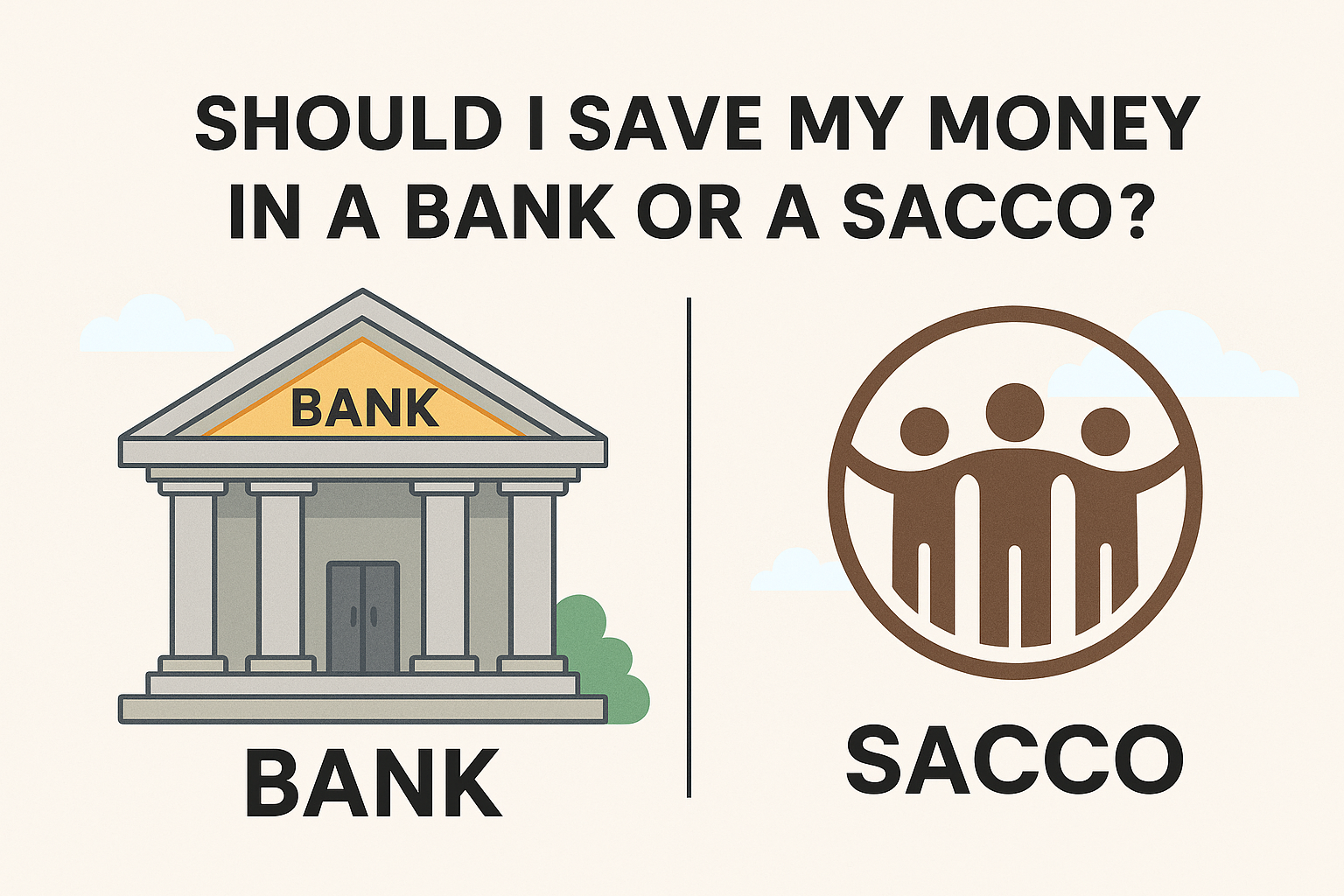One of the fundamental decisions every person who earns or receives money must make is: where should I keep my savings? Should I deposit my funds in a commercial bank, or should I join a SACCO (Savings and Credit Cooperative Organization)? This question is particularly relevant in Kenya where SACCOs are an established alternative to banks, often catering to specific communities, workplaces, or professions.
In this article, we will examine:
- What banks and SACCOs are, and how they differ
- The advantages and disadvantages of saving with each
- Key risks and how to mitigate them
- How to choose between them depending on one’s situation
- Recommendations and practical tips
By the end, you should have a clearer view of which option (or combination of options) might best suit your financial goals.
Definitions & Basic Institutions
What is a Bank?
A bank is a regulated financial institution that accepts deposits, offers checking/savings accounts, lends money, issues credit, offers investment products, and generally operates for profit (serving shareholders). In Kenya, banks are regulated by the Central Bank of Kenya (CBK).
When you deposit money in a bank, the bank typically pays you interest (sometimes very modest), and intermediation allows the bank to lend those deposits to borrowers (with interest). The bank earns by charging interest on loans, fees, and other services.
What is a SACCO?
SACCO stands for Savings and Credit Cooperative Organization (sometimes called Savings & Credit Cooperative Society). It is a cooperative institution owned by its members, who deposit savings and can borrow from the pooled resources. SACCOs are often formed by people who share a common bond (same employer, profession, locality, or faith group).
Key features of SACCOs:
- Member-owned: the savers are also owners and participants in governance
- Cooperative in nature: profits (surplus) are often shared among members (dividends)
- Focus on serving member needs rather than maximizing profit
- Regulated under SACCO laws or authorities (in Kenya, regulated by SACCO Societies Regulatory Authority, SASRA)
SACCOs often provide both savings and credit functions: members save, and may borrow against those savings (or based on share capital). They may also provide dividends on share capital and rebates based on profits.
Because SACCOs are local and more intimately connected to their members, they sometimes offer advantages (but also have risks) relative to formal banks.
Key Comparative Dimensions: Bank vs SACCO
To decide between a bank or a SACCO, it helps to compare them across multiple dimensions. Below is a comparative framework:
| Dimension | Advantage (Bank) | Advantage (SACCO) | Comments / caveats |
|---|---|---|---|
| Interest (or returns) on savings | More stability for large sums; banks have scale, liquidity | Often higher interest rates, plus dividends/shared surplus | SACCOs often advertise better returns on savings |
| Access to credit / loans | Banks have more lending products, can provide large loans | Easier access, more flexible terms, lower interest rates | SACCOs are sometimes willing to lend based on membership and savings, not just collateral |
| Ownership / control | You are a customer | You are a member / owner | SACCO members often vote, participate in decision making |
| Fees / charges | Banks may charge more in maintenance, penalties, hidden costs | Typically lower fees, more transparent | SACCOs usually have lower overheads |
| Membership / access | Anyone who meets requirements | Usually restricted (by employer, location, profession) | SACCOs often require common bond; not everyone can just join any SACCO |
| Regulation / safety | Strong regulatory frameworks, deposit insurance (depending on country) | Regulated (e.g. in Kenya by SASRA) but weaker safety nets | Always check the regulatory environment and risk protection |
| Liquidity / withdrawal flexibility | Banks often allow instant withdrawals, transfers, ATM access | May have withdrawal restrictions, lock-in periods | SACCOs may limit how often you can withdraw or partial withdrawals |
| Scale / infrastructure | Banks have wide branch networks, ATM networks, digital reach | Many SACCOs are now adopting digital platforms, but may be limited | With technology, many SACCOs are catching up |
| Profit / surplus sharing | Profit goes to shareholders | Surplus is shared with members (dividends) | This is one of the core cooperative advantages |
| Risk of mismanagement / collapse | Well-capitalized banks with oversight tend to be safer | Some SACCOs may suffer governance issues, weak oversight | Must choose a reputable and well-managed SACCO |
Advantages of Saving in a SACCO
- Higher Interest / Better Returns
SACCOs often offer higher interest rates on savings compared to banks. Moreover, many SACCOs distribute dividends or profit rebates at the end of the year, so your savings effectively earn two layers of returns (interest + surplus sharing). - Lower Loan Interest and Easier Access to Credit
Members of SACCOs often get preferential access to loans because the pooled funds are intended to serve members. Lending criteria are often less strict, collateral requirements lower, and interest rates more favorable. Some SACCOs allow members to borrow many times their savings (e.g. 3× or 4×) with flexible repayment. - Member Ownership and Democratic Control
In a SACCO, members have a say in decision making — electing board members, approving policies, etc. - Lower Fees / Charges and Greater Transparency
SACCOs often have lower charges for account operations (maintenance, withdrawals, administration) and tend to be more transparent in fee structure. - Better Support, Community Focus & Tailored Services
Because of the close link to members, SACCOs can offer more personalized services, more financial education, and tailor products to member needs. They also cultivate a savings culture among members. - Encouragement of Savings Discipline
Being a member of a SACCO often encourages you to save regularly (for instance through mandatory contributions or periodic deposits). This helps in building a habit of saving. - Profit Redistribution
Unlike banks (which distribute profits to shareholders), a SACCO’s surplus is redistributed to its members (based on shares or deposit levels) in form of dividends or rebates. - Flexibility and Innovation (especially in tech adoption)
Many SACCOs are now adopting technology (mobile apps, online platforms, USSD, integration with M-Pesa). - Lower Collateral Requirements
Because the lending is among members and backed by shared capital, many SACCOs require less stringent collateral compared to commercial banks. - Trust and Member Loyalty
Members often feel more trust with a cooperative they belong to. There is often greater accountability to members because they are also owners.
Advantages of Saving in a Bank
- Safety, Stability, and Scale
Banks are typically large, well-capitalized, and regulated. They have risk management systems, reserves, and oversight mechanisms, which may make them safer for large sums or for people who value institutional security. - Deposit Insurance / Guarantee (if available)
In many jurisdictions, bank deposits are insured (or guaranteed) up to a certain limit, helping protect depositors in the event of bank failure. In Kenya, for example, under the Kenya Deposit Insurance Corporation (KDIC), deposit protection may cover deposits in licensed banks. - Liquidity & Access (Branches, ATMs, Digital Channels)
Banks often have extensive branch networks, many ATMs, and mature digital banking platforms. This makes deposit, withdrawal, transfers, ATM access, and other transactions more seamless. - Wide Range of Financial Products
Banks offer a full suite: current accounts, checking accounts, fixed deposits, investment products, foreign exchange, credit cards, business loans, trade finance, insurance products, etc. - Credit Access and Larger Loans
Banks can offer larger, more complex financing (e.g. mortgages, business loans, syndicated loans) that SACCOs may not have capacity to support. - Professional Governance and Oversight
Big banks tend to have professional management, risk oversight, audits, and reporting systems. - Predictability & Standards
Banks often have standardized processes, which may make expectations clearer (e.g. interest rate schedules, withdrawal rules, fees). - Access for those outside SACCO “common bonds”
If you don’t belong to a SACCO, a bank gives you access independent of those constraints.
Disadvantages / Risks
SACCOs
- Governance risk, mismanagement, or fraud
- Liquidity constraints and withdrawal limits
- Membership restrictions
- Limited product offerings
- Weaker safety nets compared to banks
- Risk concentration in local investments
Banks
- Low interest on savings
- High fees and hidden charges
- Strict lending criteria
- Profit prioritization over customer needs
- Bureaucracy and inflexibility
Which Option is Better?
It depends on your situation.
- Choose a SACCO if you want higher returns, easier access to loans, and community ownership.
- Choose a Bank if you want safety, liquidity, and access to a wider range of products.
- Best of all, diversify: use both, aligning each with your financial goals.
Practical Tips
- Do due diligence on the institution.
- Check regulation and licensing.
- Understand fees, interest, and withdrawal terms.
- Don’t put all your money in one place.
- Monitor performance regularly.
- Participate in SACCO governance.
- Use institutions with strong digital access.
- Compare net returns after fees and inflation.
- Watch out for “too good to be true” promises.
- Match savings vehicles to your time horizon.
Hypothetical Examples
- KES 200,000 savings for a year: Bank at 4% → ~KES 8,000 vs SACCO at 10% (interest + dividends) → ~KES 20,000.
- KES 100,000 loan: Bank at 14% with strict collateral vs SACCO at 9% with flexible terms.
- Frequent withdrawals: Bank better due to liquidity.
Conclusion
Both banks and SACCOs serve important roles. Banks bring safety, scale, and a wide product range. SACCOs bring community ownership, higher returns, and affordable credit.
The best strategy is not either/or, but both: use banks for liquidity and safety, SACCOs for better returns and access to credit. Always research the institution you choose, diversify your funds, and align your choice with your financial goals.
Frequently Asked Questions (FAQs)
1. What is the main difference between a bank and a SACCO?
A bank is a profit-driven financial institution regulated by the Central Bank of Kenya, while a SACCO is a member-owned cooperative regulated by the SACCO Societies Regulatory Authority (SASRA). Banks focus on maximizing shareholder returns, whereas SACCOs focus on serving their members through higher returns on savings and affordable loans.
2. Are my savings safer in a bank or in a SACCO?
Generally, banks are considered safer because deposits are insured under the Kenya Deposit Insurance Corporation (KDIC) up to a certain limit, and banks are tightly regulated. SACCOs are also regulated but may not always provide deposit insurance. The safety of your money in a SACCO largely depends on the strength of its management, governance, and compliance with regulations.
3. Why do SACCOs often offer higher interest rates than banks?
SACCOs operate on a not-for-profit model. Instead of paying external shareholders, they return surplus earnings to members through dividends and rebates. This allows members to enjoy higher interest rates on savings and lower interest rates on loans compared to banks.
4. Can I access my money easily from a SACCO like I do with a bank?
Not always. Banks offer greater liquidity through ATMs, mobile banking, and instant withdrawals. SACCOs may have restrictions on withdrawals, sometimes requiring notice or limiting frequency. However, many SACCOs are increasingly adopting digital platforms to improve accessibility.
5. Which is better for loans — banks or SACCOs?
For small to medium-sized loans, SACCOs are usually better because they offer lower interest rates and more flexible terms. For larger loans, like mortgages or corporate financing, banks are often the better choice because they have more resources and products tailored for such needs.
6. Should I only save in one — bank or SACCO?
No. The best approach is often diversification. Use a bank for safety, liquidity, and large transactions, and use a SACCO for higher returns and affordable loans. This way you enjoy the strengths of both while reducing your risks.


